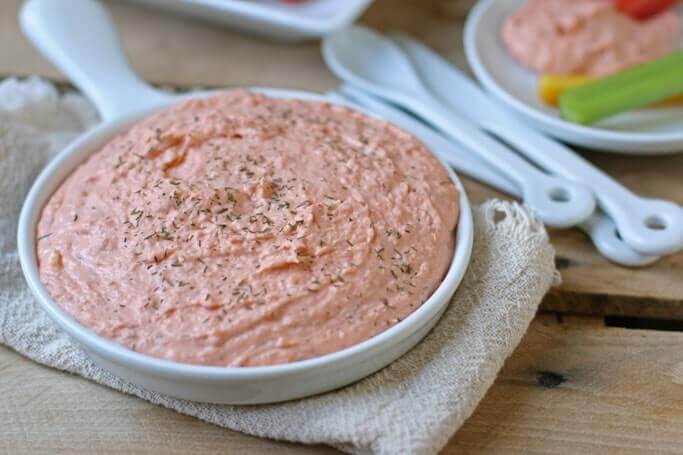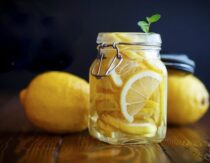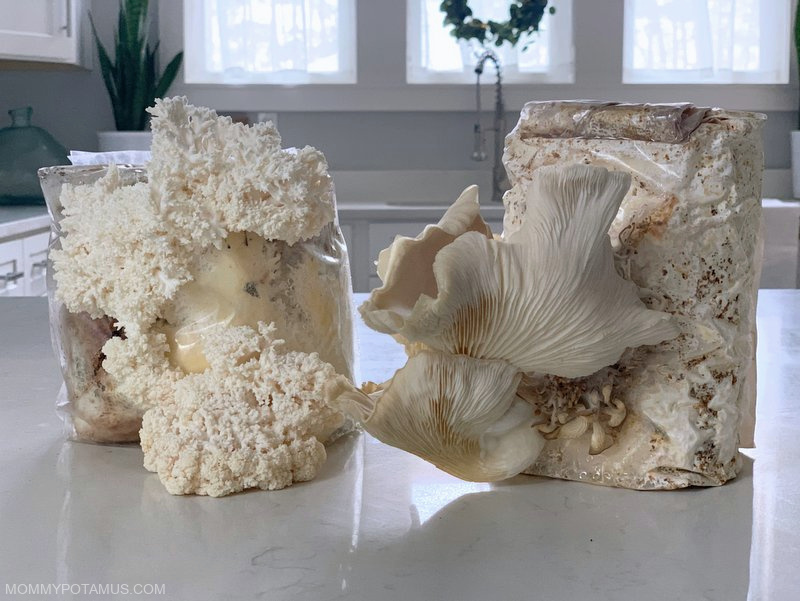
Ready to add fresh oyster mushrooms to your gluten-free pizza, or pull some sizzling stuffed shiitake mushrooms out of the oven? Maybe you’re more of a seafood person – in that case, I suggest sautéeing lion’s mane (which tastes similar to crab or lobster) in garlic butter.
Growing your own mushrooms for both culinary and therapeutic use is easier than you might think – at least if you choose a good variety for beginners and a simple cultivation method.
I’ve grown them both indoors and outdoors in a variety of ways – on coffee grounds, oak logs and sawdust – and in my experience mushroom kits are the easiest way to go.
In this article we’ll dive into the best varieties for beginners, plus ideas for using each one. But first, you might be wondering . . . .
What exactly is a mushroom grow kit?
I’ll admit, I think of mushrooms as plants. Technically, though, they’re not part of the plant or animal kingdom, but they borrow traits from both sides. For example,
- Their cell walls are made with chitin, which is what lobster shells are made of. (Plants use cellulose.)
- But they grow out of soil, decaying wood, etc.
In some ways, they do things completely differently from both plants and animals. For example, plants nourish themselves via photosynthesis, animals nourish themselves by ingesting food, and fungi nourish themselves by releasing digestive enzymes, then digesting absorbing nutrients from their surroundings. (They don’t have chlorophyll and can’t use the sun to make energy.)
There are lots of other differences, too, but for the purpose of growing mushrooms here what you need to know:
- Most plants are grown from seeds, but mushrooms are grown from spores.
- When spores mix with wood, soil or another growing medium like coffee grounds, thin white mycelium begin to grow. Mycelium look like long, thin roots, but they’re more like the roots and the main plant combined.
- What we typically call mushrooms are actually the fruit – technically called fruiting bodies – of the mushroom. If they’re allowed to stick around long enough (in other words, as long as no one eats them), the fruiting bodies will release spores that will grow more mycelium and start the whole process over again.
When you buy a mushroom kit, you’re getting a growing medium with mycelium already growing in it. That’s a good thing for a few reasons:
1. You don’t have to stress over finding the right growing medium for your mushrooms
If you want to do things from scratch, it can take a little effort to gather your materials. When I first started growing mushrooms, I wanted to use logs as a substrate (growing medium).
But . . . I didn’t have any logs or any trees that I could cut down. And I didn’t just need random logs, but logs from specific kinds of trees.
Eventually I found some by calling a bunch of tree trimming services. One wonderful man who owned a trimming service didn’t have what I needed, but he was so interested in my “I want to teach mushroom cultivation to my kids” explanation that he actually cut me a log from one of the trees on his farm to help us get started. So yeah, if you want to do things from scratch be prepared to get creative about sourcing your materials.
2. You don’t have to sterilize anything
Before mixing spores with a growing medium (often called a substrate), it’s best to sterilize the substrate before adding them in. That way, the likelihood that you’ll grow mushrooms instead of some random mold that was already hanging around in the substrate increases.
When you get a kit that already has mycelium growing, you get to skip the sterilization process. Plus, you can see the mycelium growing, so you know you’ve got a good batch.
3. You’ll get delicious mushrooms faster
When the mycelium are already established, it takes a lot less time for them to get to the harvest phase. Your main job is to keep the growing medium moist and make sure they’re placed in a spot where they can thrive . . . usually an area with indirect sunlight.
Once the first fruiting occurs, you can often get 2-3 more flushes (that’s mycospeak for harvests) by continuing to mist the kits. Some of ours have fruited so many times we’ve lost count!
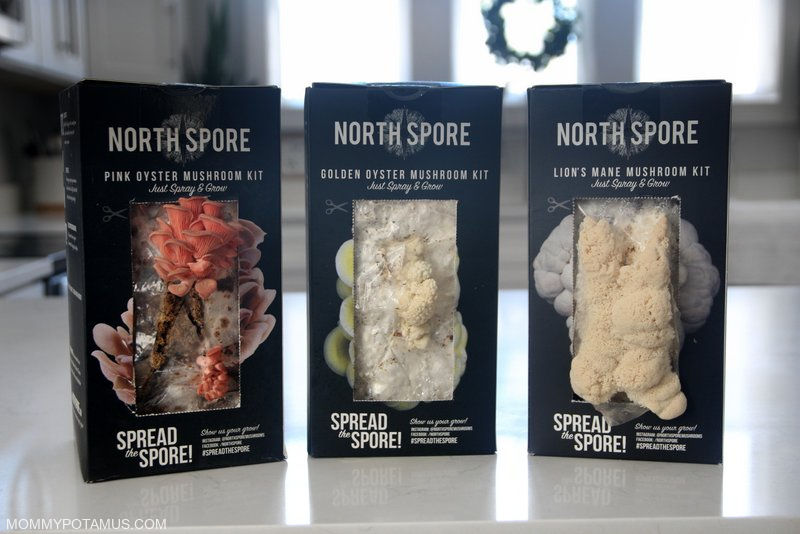
Best Mushroom Kits for Beginners
- Oyster mushrooms
- Lion’s mane
- Reishi
Quick note: As you may know, I personally buy 99.99% of the products I test for review on this site. However, last fall a couple of companies offered to give me a wide variety of kits to test all at once, and I agreed because I thought it would be helpful to compare them. My opinions are my own, though. 🙂
Oyster Mushrooms
Oyster mushrooms are super easy to grow right on your kitchen counter, and there both delicious from a culinary perspective and chock-full of therapeutic benefits, including:
- Helping “melt away the stress of the workday”
- Supporting immune function
- Promoting even skin pigmentation (It’s used both externally and internally to even sun spots and freckles, though personally I’m a huge fan of freckles)
They get their name because of their appearance, not their flavor, which may be a relief to some of you. So far I’ve grown pearl oyster (Pleurotus ostreatus), pink oyster (Pleurotus salmoneostramineus), and blue oyster (Pleurotus Columbinus) mushrooms from two different companies.
Here are my top picks:
Pearl Oyster Mushrooms (Pleurotus ostreatus)
This is the variety you typically find in the gourmet mushroom section of some grocery stores. We used this method with a kit from True Leaf Market to cultivate ours, which is pictured at the top of this article. Unfortunately it’s not available right now, but I’ve included links to several other types of oyster mushrooms – pink, blue, and golden – below.
It took several weeks of daily misting inside the humidity tent for the mushrooms to start growing, but once they did they were huge, absolutely gorgeous, and tasty.
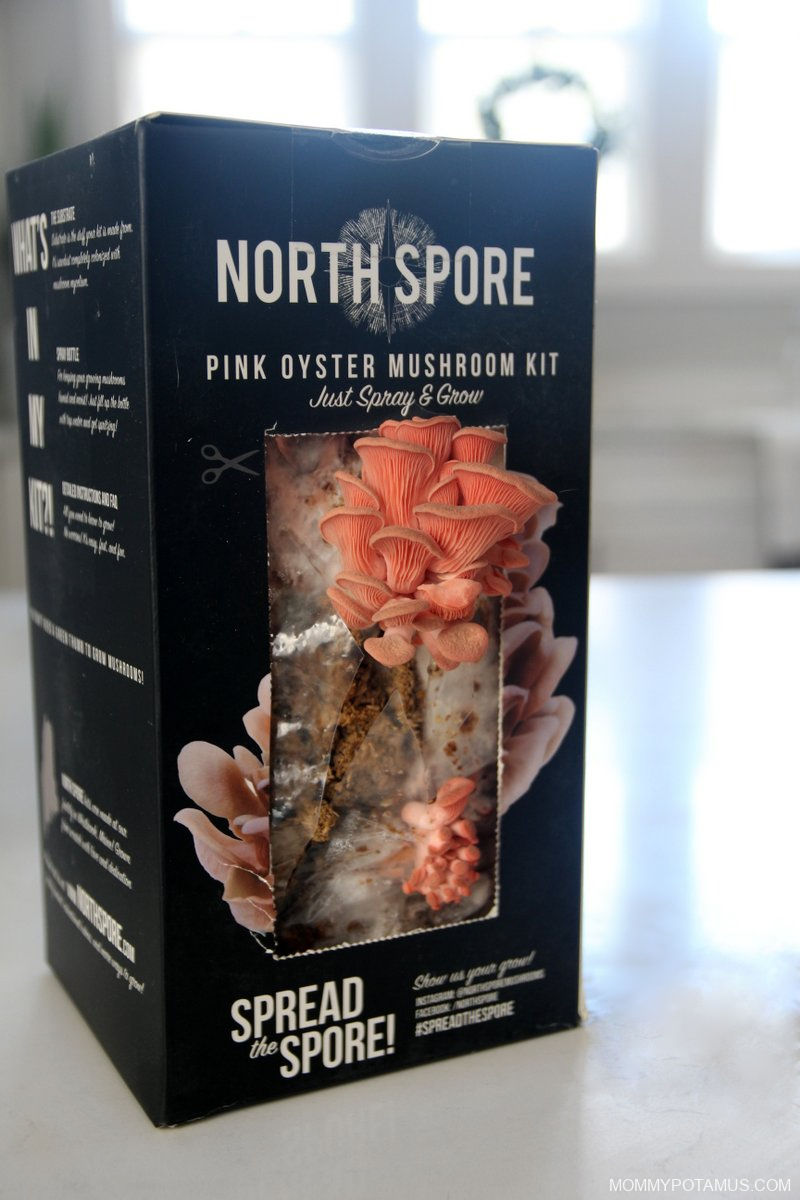
Pink Oyster Mushrooms (Pleurotus salmoneostramineus)
I really can’t say enough good things about the North Spore Spray & Grow Kits. They’re ridiculously easy to care for – you just cut a pattern in the plastic front and mist it daily with the spray bottle provided – and then the kits produce gorgeous clusters of mushrooms.
North Spore guarantees that your kit will fruit at least once, but ours have fruited several times more than that . . . I think around 3-4, though I lost count because we had so many growing all at once.
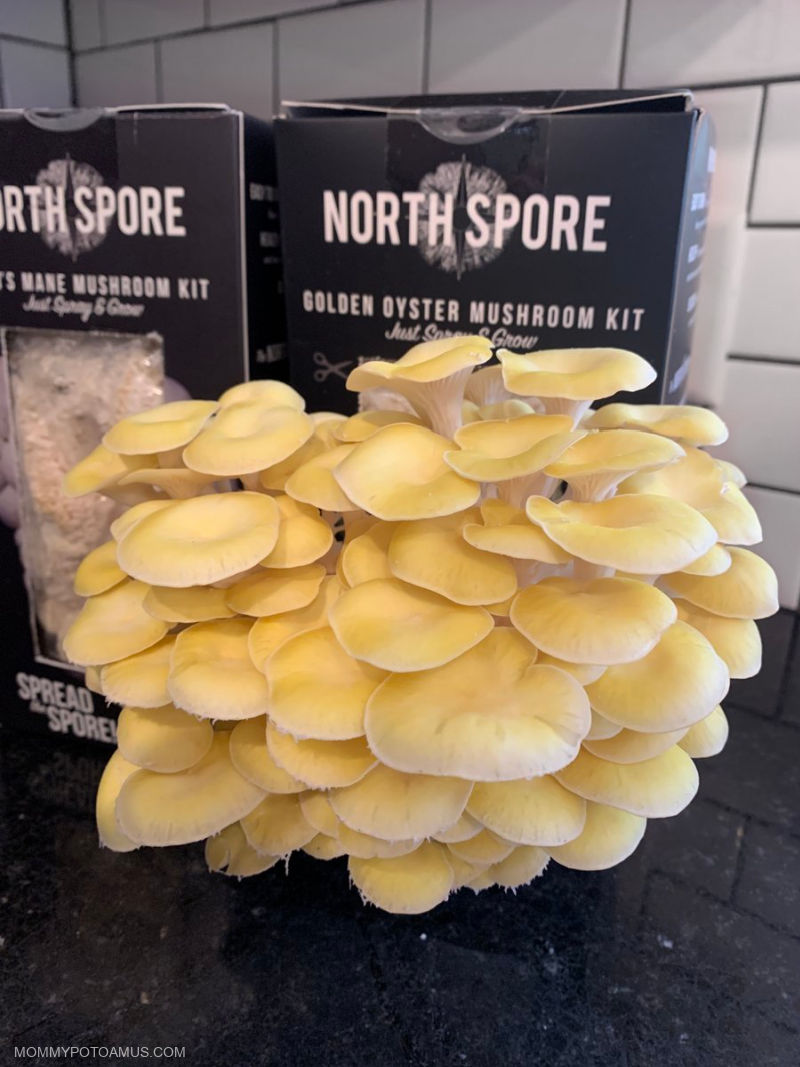
Golden Oyster Mushrooms
So, I started all of these kits a few weeks before I needed to take a short trip . . . not realizing that I’d need to bring them all with me so that I could mist them daily. 🙂
The Golden Oyster Spray & Grow Kit from North Spore was the star of the trip – once it got going it nearly outgrew the big box I put it in for transport, then produced several more flushes when we got home.
Blue Oyster Mushrooms
Most of North Spore’s Kits fruited pretty quickly after arriving, but we did have a straggler – the Blue Oyster Spray & Grow Kit. Fortunately, the wait was well worth it – the mushrooms were deep blue when they first appeared, though the color became more of a muted grayish-blue as they grew larger.
I thought I snapped a photo but apparently I didn’t. I’ll try to get one next time.
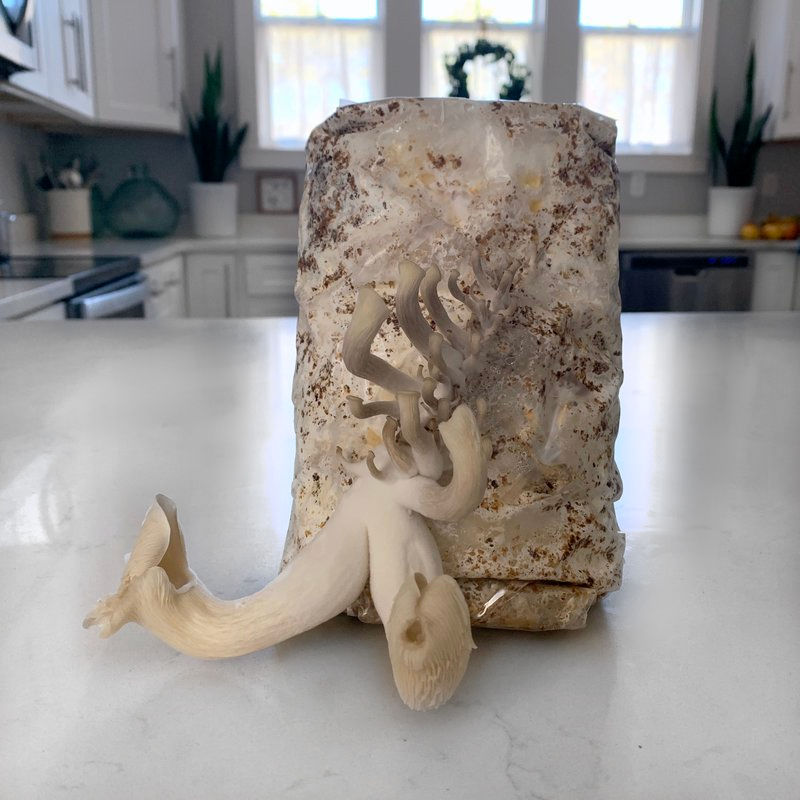
True Leaf Market also sells a Blue Oyster Mojo Pro Kit that is currently out of stock. Ours were not the same deep blue as the North Spore ones, but they were much larger and kind of looked kind of alien-ish which my kids thought was interesting. (See the photo above.)
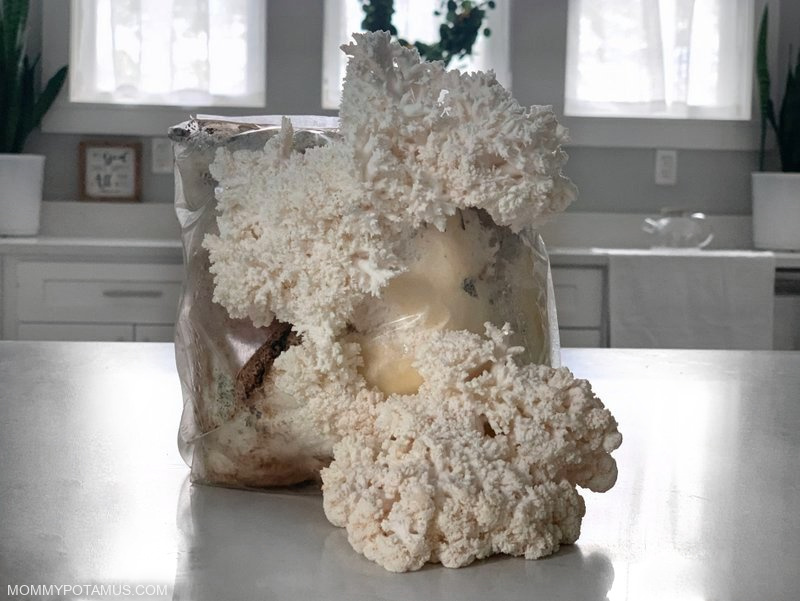
Lion’s Mane Mushrooms (Hericium erinaceus)
Lion’s mane supports the repair & regeneration of neurons, resulting in improved cognitive function. I dive into how it benefits the brain, nervous system, immune system, gut, stress resilience and more in this article.
Oh, and there’s that whole “tastes similar to lobster/crab” thing, too. Both lion’s mane kits that we tried were huge hits.
The Spray & Grow Kit from North Spore was quick to fruit. This Mojo Pro Kit took longer but produced a series of big, meaty mushrooms that were worth the wait. Both kits get five stars from us.
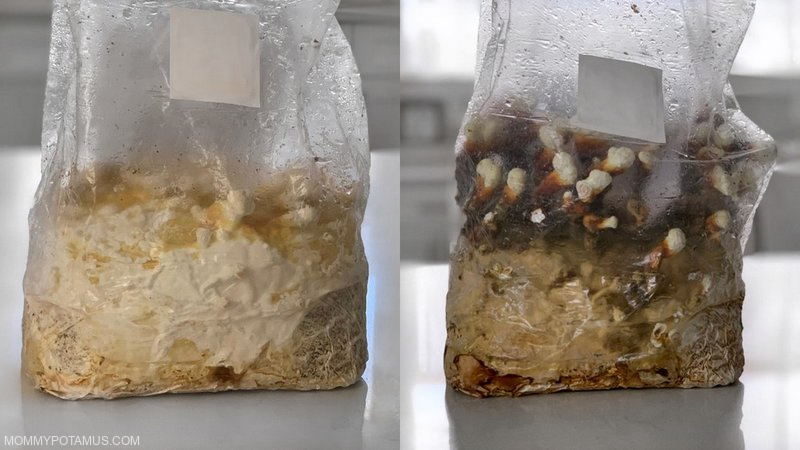
Reishi Mushrooms (Ganoderma lucidum)
Sometimes referred to as the “Mushroom of Immortality,” reishi has traditionally been used to promote longevity, support immune function, increase stress resilience, improve mental clarity and more.
It’s rare to find in the wild, and for thousands of years was mostly reserved for the Chinese emperor and his court. Fortunately for us, it can now be cultivated.
This kit basically requires zero effort but takes time to mature. It comes sealed inside a clear bag which provides the perfect ecosystem for it, so you just put the bag in bright indirect sunlight and leave it alone until you’re ready to harvest. There’s no need to mist it with water at all.
In the photo above you can see the reishi I’m currently growing – it took about five weeks for it to grow from the photo on the left to photo on the right.
One important thing to know about reishi is that although it is technically an edible mushroom, it’s not the kind of mushroom you cook and eat for dinner. Reishi has a very woody texture – similar to a wine cork – and it takes a little effort to coax the therapeutic properties out.
I’ve shared how to use dried reishi to make a tea or tincture in this article, and I’ll be updating it with instructions for using fresh reishi as soon as mine is ready for harvest.
Shiitake Mushrooms (Lentinula edodes)
I haven’t tested this Shiitake Mushroom Fruiting Block Kit yet, but it’s on my list to try. Shiitake mushrooms support liver and kidney health, and they’re absolutely delicious when marinated and added to shish kabobs or sautéed in stir fry.
Based on my experience with growing mushrooms in a variety of ways, I’d say this kit borders on the edge of beginner/intermediate in terms of the skill level needed. It’s definitely not difficult, but it may require a little more attention than the options above.
Outdoor Mushroom Log Kits
Now that we’ve covered some of the mushrooms you can grow on your kitchen counter, let’s talk about some of the ones you can grow outside.
Mushroom log kits are logs that have been infused with mushroom spawn – aka a little bit of mycelium growing in a substrate like a wooden plug that’s shaped like a pill/supplement.
You infuse the logs yourself by drilling holes and placing the supplement-shaped spawn inside with kits like this, then placing wax over the area so that the mycelium can begin to colonize the log. It takes time – sometimes a year or more – so be prepared to be patient.
Recipes To Try
- Add mushrooms to soups and stews (except reishi, see section above for why)
- Sauté oyster mushrooms with butter and garlic (Here’s a recipe to try)
- Toss them into oyster mushroom noodle stir-fry (Use coconut aminos instead of soy sauce if you’re soy-free)
- Make lion’s mane “crab” cakes
- Dry sauté lion’s mane mushrooms, then finish with olive oil and salt
- Make fresh reishi tea (recipe coming soon)
- Bake shiitake mushrooms stuffed with olives and sundried tomatoes (or cheese, that’s always a favorite)
- Whip up a ginger, beef, and mushroom stir fry
Have a question about growing mushrooms at home? Leave a comment below!
Are you familiar with adaptogens?
Adaptogens are one of the most beneficial types of herbs for stressed, tired moms, but there’s a lot of uncertainty about what’s safe for pregnancy and nursing. I’ve created a free ebook for you – The Beginner’s Guide to Adaptogens – as a gift for signing up for my newsletter.
I researched ten different herbs in the Botanical Safety Handbook and wrote several herb profiles that include benefits, safety info, and recommendations from an expert (ethnobotanist) on how to take them. As a subscriber, you’ll also get updates when I post new recipes and research, exclusive sales and coupons on my favorite products.
Sign up using the form below.

